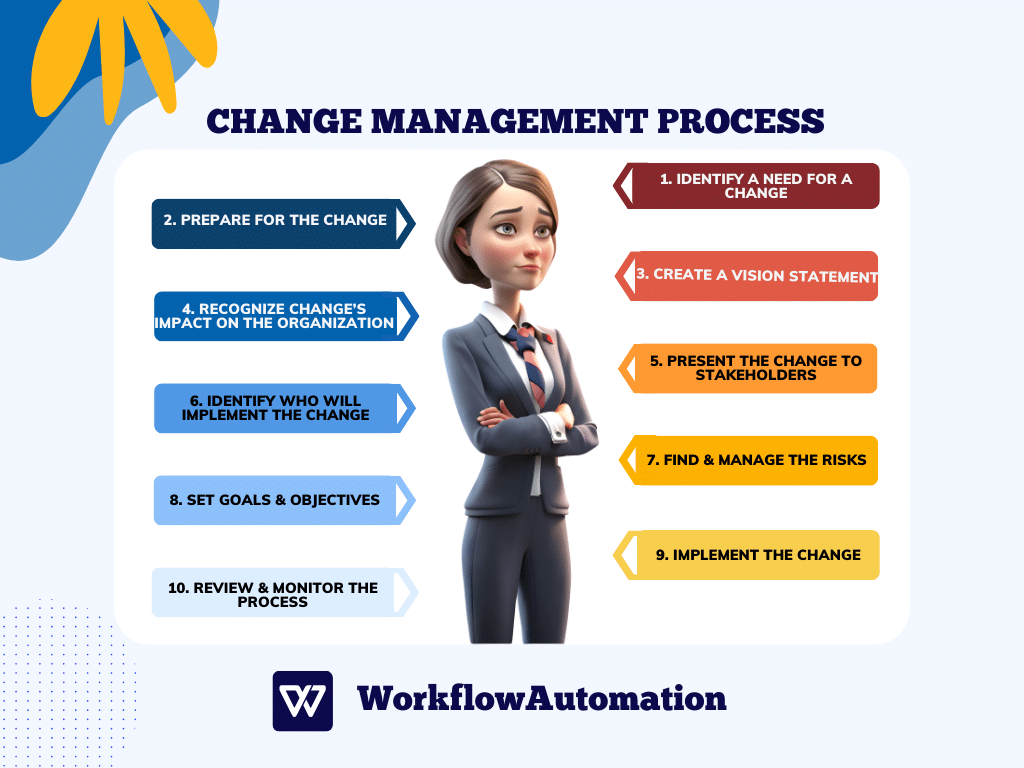It is unrealistic to expect that your team or company will remain easily competitive in today’s world with almost daily changes, so you must be prepared to find appropriate solutions for any situation that may compromise your business. An effective change management process is the solution you need.
It is understandable that before any change, there are always considerations about what the outcome of that change will be—how it will affect your business, your employees, and ultimately, yourself.
That is why we prepared a guide on everything you need to understand the change management process and why it is essential to be decisive and systematic when implementing solutions. We’ll provide you with a few change management process examples as well!
So, let’s get started!
Key Takeaways
- It is necessary to identify the need for change and communicate with relevant stakeholders to create a plan for further change process action.
- The plan should include clearly defined change objectives, employee engagement in implementing those changes, and emphasis on communication and collaboration to ensure consistency in their approach.
- By following a plan approved by all parties involved in the change process, the team can expect a more efficient approach than the previous one, a reduction of excessive resource utilization, improved employee attitude towards changes, and overall company growth.
What is Change Management?
Change management is a systematic approach to improving existing business processes and conditions. This methodical approach cannot and should not be a prompt implementation of solutions with the expectation of immediate results. It’s a process that requires time and patience.
It involves decisions that trigger a company’s human, technological, and financial components and affect its status. The reasons for the change management implementation can be the introduction of new technology, an economic crisis, the merger of two companies, changes in the company’s management structure, and more.
In response to all these factors, board members, employees, and other parties involved must be ready for change in line with the company’s vision and goals to avoid negative effects and stagnation. It is crucial to notice when it is time for a change so the company can start with the preparation and implementation of the solution.
10 Steps of Change Management Process
The change management process entails a structured procedure, a defined timeframe, and a series of steps that guide the entire journey from recognizing the need for change to its implementation.
Below, we provide a step-by-step change management process guide.
#1. Identify the Need for a Change
The first step in successfully implementing the change management process is identifying improvement areas. These improvement areas can refer to poor performance and inefficiency, the introduction of new technology in the field, and so on.
Recognizing the need for change is the most crucial step as it lays the foundation; without it, there can be no progress.
For instance, in the context of agriculture, embracing technological advancements to substitute manual labor and automate various processes becomes imperative to attain higher levels of productivity.
#2. Prepare for the Change
Once you’ve identified the areas for improvement, you must choose the best strategy to put those improvements into action. Thorough research and analysis are the greatest ways to accomplish this.
During the research phase, it is essential to collect relevant data. For example, let’s say you are considering implementing the use of a new time-tracking software within your company. In that case, exploring the various time-tracking solutions available and carefully assessing their alignment with your organization’s operations is essential, considering costs and benefits.
Compare and analyze all the collected data to choose the right one.
#3. Create a Vision Statement
Before the change implementation process, you must present your team and stakeholders with your vision regarding the change you are introducing. In other words, what do you expect after implementing the change?
#4. Recognize Change’s Impact on the Organization
The implementation process is not straightforward and may encounter various resistances. So, before embarking on the implementation, it is crucial to anticipate the impact of the changes on your existing organizational structure, employees, and workflows based on available facts.
That necessitates effective communication with all stakeholders affected by the change. Understanding the impact of the implementation process on the organization plays a pivotal role in devising a strategy for the most effective change implementation.
#5. Present the Proposed Change to Stakeholders
This step involves engaging stakeholders in the change process due to their interests and the potential influence the implementation can have on their needs and vision.
You and your stakeholders need to assess how certain aspects might affect ongoing tasks and the execution of existing projects. It is essential to align stakeholders’ expectations with the change implementation process to successfully implement the change, satisfying all parties involved.
#6. Identify Who Will Implement the Change
To implement a significant change, it is crucial to identify the right individuals and assign them relevant roles. Therefore, find experts in the field, i.e., competent professionals who can efficiently and effectively implement the change and ensure its continuous application.
Inform the person responsible for the change implementation about the organization’s objectives, provide well-defined tasks and roles, and foster good communication and collaboration.
That entails openness, honesty, and feedback, all aimed at facilitating a successful implementation process.
#7. Find the Risks & Manage Them
Identify potential challenges that can arise during the implementation process and prepare to mitigate them. Find ways to address and resolve these risks to successfully implement the change.
For example, if your workforce consists of older individuals who may have difficulty adapting to changes, particularly regarding technology, anticipate resistance or challenges in training adoption.
#8. Set Goals & Objectives
Define a clear goal you aim to achieve through the change implementation, along with smaller milestones to gauge progress during the implementation process. Inform all involved parties about the plans to ensure everyone understands their roles and ultimate goal.
You can use project management tools like ClickUp or Jira, which allows you to define and document specific goals, objectives, and key performance indicators (KPIs) associated with the change initiative.
#9. Implement the Change
Once the entire organization and stakeholders are informed about the change, the implementation approach, the overseeing leadership, the roles and responsibilities during the implementation process, and the goals, it is time to initiate the implementation process.
During the implementation phase, tools like Basecamp and Trello can help you execute the plan, track tasks, and keep communication channels open.
#10. Review & Monitor the Process
Stay informed and monitor the progress of the implementation process, ensuring it aligns with the defined goals.
Assess the organization’s and stakeholders’ reactions and identify any deviations from the planned course. Respond appropriately to emerging demands during the execution phase and ensure a successful outcome.
Change Management Types
Let’s have a look at the four types of change management:
Anticipatory
This type of change can be classified as proactive change management, guided by the principle that effective preparation is the cornerstone of success. It involves implementing pre-planned strategies in anticipation of events or factors that are expected to occur in the future.
In this way, it leaves little or no room for the organization to be unable to align with expected changes. Some authors classify anticipatory adaptation as “tuning in,” which represents adjustments within the existing functioning system, and “reorientation,” which involves a broader organizational structure and strategy changes.
Reactive
Compared to the previous type of change, the reactive change type is a response to unforeseen circumstances, which means that organizations often do not have time for a detailed analysis and preparation of measures for the newly emerged situation.
Examples of this type of change are often associated with severe weather conditions or unforeseen crises that force organizations to act promptly and find appropriate solutions.
Incremental
Incremental changes are implemented on individuals (employees, board staff, etc.) and smaller organizational units and processes to gradually make a significant difference.
Therefore, they do not involve a departure from existing policies and ways of doing business but rather entail implementing small changes whose results will resonate in the future.
Strategic
Strategic changes are significant shifts in a company’s overall direction, core strategies, and business model. They usually affect many parts of the company and need careful project planning and execution to get the desired results.
An example of a strategic change is when a technology company changes focus from hardware manufacturing to software development and services.
Benefits of Change Management
- Improved alignment: Change management ensures better alignment of practices, processes, and resources with the organization’s objectives. Clearly defining the desired outcomes and aligning the change efforts accordingly helps the organization stay focused and achieve the intended results.
- Increased employee adoption: Employees are more likely to embrace new projects when actively involved in their implementation, which is the goal of change management.
Including employees in the decision-making process, responding to their questions, and giving them help and training makes the performance more accessible and improves success rates.
- Sustainable results: Change management focuses on achieving sustainable results rather than temporary fixes. By emphasizing long-term planning, continuous evaluation, and reinforcement of new behaviors and processes, the change becomes embedded within the organization’s culture.
- Increased innovation: Change management promotes creativity among employees and the company at the same time. A company’s ability to innovate and gain a competitive edge depends on the availability of a culture that encourages and rewards creative thinking.
Implementing change management practices increases the organization’s readiness for future changes. By building change capabilities, organizations become more agile, adaptable, and resilient in the face of evolving business landscapes.
Why Change Management May Fail?
Although you have taken all the steps to introduce the required change in your organization, some factors could hinder the implementation process. So, let’s reveal the best ways to prevent the change management process going awry.
Poor Communication
Poor communication is a common cause of failed change management processes and a return to old working methods. It occurs because a gap and lack of motivation for action increase when there is no open communication and clarity regarding the reasons for implementing a particular change and how to execute it.
Employees will inevitably experience resistance as they strive to understand the purpose of the change and their respective roles and responsibilities. To ensure effective implementation of the change, the organization must allocate sufficient time for distributing and providing transparent access to all relevant information, ensuring understanding.
Inconsistency
Inconsistency often sabotages the implementation of the change and typically arises when there is a lack of proper organization, such as inadequate communication or actions that are not well-planned and coordinated.
In such cases, if there is no clear plan for introducing change, training, and monitoring, and if managers are not consistent about implementing new rules, employees can become confused and quickly revert to old ways.
Rushing the Change or Moving Too Slow
One factor that can lead to the failure of change implementation is rushing into it without thoroughly researching and analyzing the best approach to introducing change or finding the appropriate individuals to train and execute it effectively.
If the implementation of change is excessively slow, the organization can lose the determination and willingness to embrace the new. Instead of accepting the change, there can be a return to old practices.
Lack of Leadership Support
The role of the leader in the change management process is crucial. The attitude of all employees towards the change depends on the leader’s leadership abilities.
So, they should enthusiastically present the benefits of the change, emphasizing the importance of its successful implementation for the organization. They should inspire and create a desire, motivation, and responsibility among employees for the upcoming implementation process.
Inadequate Training and Development
Introducing new work processes, new technologies, or any other changes requires investment in proper training and mentoring.
A good training program should involve employees in the change implementation process, equip them with knowledge and skills, understand their needs and concerns, provide feedback, and foster a healthy atmosphere and self-confidence among employees.
By dedicating attention to providing adequate training and ensuring the proper utilization of new requirements, organizations can prevent future mistakes, improper usage, and resistance and achieve efficiency and increased productivity.
How to Improve Change Management Process
Since there is always room for improvement, we present you with five tips on enhancing the entire change management process and ensuring a more successful implementation.
By following these recommendations, you can facilitate a smooth and efficient transition and achieve the desired outcomes.
#1. Be Transparent
To successfully implement change, establish effective communication channels. Be transparent by presenting a clear goal for the changes and the reasons behind their implementation.
Ensure that information circulates throughout the process, including all updates, suggestions, and concerns, and create a relationship of trust.
#2. Engage Employees
Involve your employees in the change management process, as the outcome depends greatly on their participation.
Exchange ideas with your employees, share your vision for the change, and actively welcome their beliefs, suggestions, and concerns. Ensure a seamless flow of information and encourage ongoing feedback.
#3. Develop a Clear Change Strategy
The strategy for introducing change should be clear to everyone involved. Present your ultimate goal as well as key objectives throughout the process. Communicating the implementation project timeline helps set realistic expectations and provides insight into the process.
#4. Monitor Progress and Adjust
Improving the change management process and achieving good results can be enhanced by monitoring the implementation process and proactively responding to emerging demands and changes.
Stay active throughout the journey towards implementation, track progress, and be ready to adapt.
#5. Celebrate Milestones and Recognize Achievements
The attitude of management towards change and creating a positive energy and team spirit can enhance the overall change implementation process.
Maintain a positive outlook during the process, celebrate small successes, and acknowledge the achievements of your employees. These actions will contribute to tremendous respect, engagement, and accountability towards tasks and the organization.
Final Thoughts
Changes are not easy, and they do not always depend on your efforts but also on various external factors. Still, they are inevitable today and can have a significantly positive effect.
If changes result from unforeseen circumstances, focus on finding a solution with your team to ensure a transition to a calmer business harbor. On the other hand, if we are talking about systematically planned changes, then with the steps we mentioned, you can be sure that the company will reach its intended future position in the market.
Refrain from resisting the changes, but embrace their flow and do your best to adapt to them following your principles and vision!







